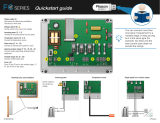
2 IOMM ACZ/AGZ-2
Table of Contents
Introduction.......................................3
Inspection.................................................... 3
Installation.........................................4
Handling...................................................... 4
Location....................................................... 5
Service Access............................................. 5
Vibration Isolators....................................... 7
Water Piping................................................ 8
Flow Switch................................................. 9
Glycol Solutions........................................ 10
Evaporator Flow and Pressure Drop.......... 12
Refrigerant Piping ..................................... 13
Physical Data ...................................18
Electrical Data.................................21
Field Wiring............................................... 21
Electrical Data AGZ-AM........................... 22
Electrical Data ACZ................................... 22
Electrical Notes ......................................... 23
Wiring Diagrams ....................................... 25
Dimensional Data............................36
Startup..............................................38
Pre Start-up................................................ 38
Start-Up ..................................................... 38
Shutdown................................................... 38
Water Piping Checkout.............................. 39
Refrigerant Piping Checkout ..................... 39
Refrigerant Charging................................. 40
Electrical Check Out.................................. 41
Operation .........................................42
Sequence of Operation .............................. 42
Hot Gas Bypass (Optional)........................ 43
Filter Driers ............................................... 44
System Adjustment ....................................44
Liquid Sightglass and Moisture Indicator..44
Thermostatic Expansion Valve...................44
Crankcase Heaters...................................... 45
Water Cooler.............................................. 45
Global UNT Controller, AGZ-AM.46
General Description...................................46
Optional Sensors........................................ 46
Controller Inputs /Outputs ......................... 48
Additional UNT Features...........................51
Alarms........................................................53
ZONE TERMINAL (optional)................... 54
Zone Terminal Glossary.............................58
Global UNT Controller Troubleshooting
Chart..........................................................60
MicroTech Controller, AGZ-AM....61
General Description...................................61
Optional Sensor Packages..........................61
Installation.................................................61
Sequence of Operation...............................70
Start-Up and Shutdown.............................. 72
Keypad / Display ....................................... 73
Menu Descriptions.....................................76
Trouble Analysis for the AGZ MicroTech
Controller................................................... 87
Test Procedures.......................................... 90
Unit Maintenance............................97
Preventative Maintenance Schedule ..........98
Service ..............................................99
Liquid Line Solenoid Valve .......................99
Evaporator ...............................................100
Refrigerant Charging................................100
Troubleshooting Chart .............................102
Our facility is ISO9002 Certified
"McQuay" is a registered trademark of McQuay International
2002 McQuay International
"Information represents McQuay International products at the time of publication and we reserve the right to
make changes in design and construction at anytime without notice"




















